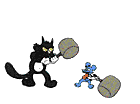The 'pastoral' name seems to link these instruments more to a 'movement' or fashion than to each other.
As for the history of bellows, it's hard to say because so many instruments were retro-fitted with bellows, we don't know whether the bellows were original. Perhaps the best evidence we have is contemporary artwork and writing:
http://homepage.mac.com/muzette/Eng.Fil ... llery.html
In the link above, note the sort of implausibly dressed "Shepherd playing the Musette" - clearly part of the romantic pastoral thing. In the painting "Bal at the Court of Henry III", dated 1581, it's unclear whether the musette player has a blowpipe in his mouth or not (unfortunately the detail is dark and blurry). So perhaps one of the first sure pieces of evidence for bellows on the musette is Praetorius' 1619 publication. Surely it had been around before that, but where it might have originated I don't think anyone knows. Note that it appears in Mersenne's drawing of an Italian yoke ("Sourdeline") in 1636,
The "Pastoral" or "New" bagpipe was probably rather a latecomer to this whole gentry-playing-peasant thing, i.e. 100 years later. By that time, perhaps a backlash against the Industrial Revolution among other things... one quickly gets into sociological speculation when looking at these things.
But it's mostly just that - speculation, since very little hard evidence exists. The paintings and drawings are about the best we have, and until the 19th century I don't know that we have ANY pictures of Pastoral, 'New', Union, or 'Irish' pipes of the bellows blown variety.
Regarding oboes - well, the various oboe family instruments like Oboe, Oboe d'amore, Cor anglais, 'baroque' oboe, etc. are really quite different from one another, as are their reeds. Capped-reed instruments were however pretty common in the 17th and 18th centuries. It would not be a huge leap to discover that cold wind/bellows blowing a reedcap instrument would allow the reed to be scraped so as to produce a second octave (provided the bore was subtle enough).
I have never seen any convincing origin for the 'New' bagpipe (aka pastoral pipe or 'hybrid union pipe' as it's been called by people who would like to think that the Pastorals were derived from the Union pipe and not vice-versa), in some earlier pipe. That doesn't mean there isn't one, but it's also plausible that it derived from a mouth blown instrument of the oboe family, in a marriage of 'art music' technology and bucolic bagpipe fantasy. Who knows?
regards
Bill
